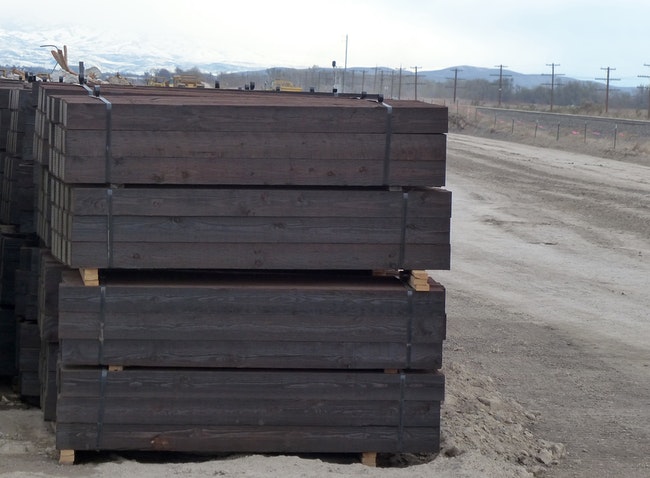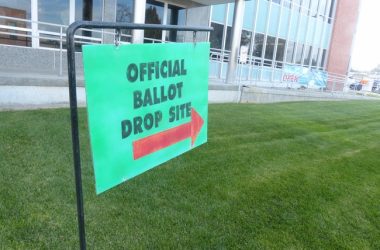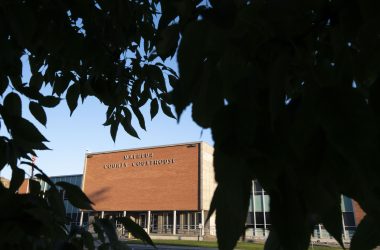
Railroad ties are stocked outside of Nyssa on Tuesday, April 12, to be used on miles of rail track planned for the Treasure Valley Reload Center. One $2.7 million track remains optional, officials say. (The Enterprise/LES ZAITZ)
VALE – Malheur County’s top official said $26 million should be enough to finish the Treasure Valley Reload Center in Nyssa.
Legislators in 2017 awarded that sum to construct the rail shipping center. Dan Joyce, Malheur County judge, said in an interview last week that “I’ve never been led to believe” the original state grant wouldn’t be enough to get onions shipping out of Nyssa.
He made the remark two days after local project leaders announced at a news conference that they needed $6 million more to finish the reload center.
Joyce said he hadn’t been told those leaders also had canceled plans for now to construct the centerpiece rail building. Project leaders announced that decision in early June.
As county judge, Joyce holds a full-time position at the top of the administrative operations of Malheur County. That includes the county’s economic development department, whose director, Greg Smith, is the project leader on the Treasure Valley Reload Center.
Joyce said Smith hadn’t told him about his intention to approach the Oregon Department of Transportation for up to $6 million more.
Last month, Joyce said he intended to press Smith on plans to “fix” problems with the reload center but that hasn’t happened.
“I just haven’t had an opportunity,” said Joyce, who was just reelected to a third term as county judge.
In the interview on Thursday, June 16, Joyce put distance between himself and the reload project as well.
He said that “in a lot of ways” his responsibility for the project ended when the county in 2017 appointed a separate board to manage the project. The Malheur County Court appointed the directors of the Malheur County Development Corp., a public company created by the county to manage the shipping center project.
“I honestly believe that they are more than capable of following through with the project to see that it’s completed,” Joyce said.
Project leaders last week took a positive view of the reload center in a telephone news conference with reporters. Smith banned the Enterprise from the June 14 conference but the Argus Observer newspaper in Ontario subsequently published a lengthy report.
Grant Kitamura, an onion industry executive and president of the development company, told reporters the project was “very close” to reality. Kitamura said the project wasn’t out of money and Smith said the project had been audited by CPAs.
The newspaper quoted a project engineer saying the reload center was “coming along very, very nicely” and that two-thirds of the reload center is done.
Project leaders said the center still could open in mid-winter.
Kitamura told reporters the news conference was being held because of negative reporting in other outlets, apparently a reference to the Enterprise.
“There are headlines that say, ‘Hey, out of money! They’re out of money!’ But we’re not out of money. We’re still going forward,” Kitamura said.
His remark apparently referred to ongoing construction and the funding on hand to pay those costs. Project leaders since April, however, have been on notice there isn’t enough money to finish the work. Key elements of the reload center, including one rail spur, truck scales and a network of roads, have been dropped but that hasn’t been enough to bring the project in on budget.
And information shared at the news conference indicates the project has encountered even more financial trouble.
A month ago, the project engineer estimated that Malheur County would need an additional $4.8 million to finish the project, including putting up the reload center building, a 60,000-square-foot complex where trucks would unload onions for transfer to rail cars.
At the news conference, Smith said the figure was now $6 million, a figure contained in an “estimated expenditures” document released to the Enterprise Friday.
Smith told reporters the project would borrow to get the money or go to the state for more public funding.
Katherine Benenati, assistant communications director at the Transportation Department, said by email that Smith had contacted the agency for a meeting but “we don’t have any formal proposals at this point.”
“We’ve been pretty clear we expect the project sponsors to complete the project as outlined in the agreement and with the funding that has been allocated,” she said.
She noted that the Transportation Department director has authority to award additional money for the Malheur County project but “at this point, no commitments for additional funds have been made.”
In May, Joyce asked legislators to $3 million to $10 million for the project. In last week’s interview, though, Joyce couldn’t readily explain what he wanted the money for.
“I’m not sure I want to answer this question right now,” he said, adding he didn’t know the fate of the request.
LISTEN TO THE INTERVIEW:
In fact, local legislators subsequently went to legislative leaders for $3 million for the reload project, a request that was denied. Joyce said he wasn’t sure that was the same money that he requested, and that all he knew about the matter was in a press release from state Sen. Lynn Findley, R-Vale.
Joyce later in the interview said the money he requested would have restored a third rail spur at the Nyssa project. Project leaders have had no public discussions about restoring that spur.
Joyce also addressed the county-owned Arcadia Industrial Park.
Malheur County bought a 290-acre parcel of farmland north of Nyssa as the site for the reload center. The plan was to split off 65 acres for the reload center and then turn the rest into industrial lots for new employers.
Joyce said the county didn’t want to buy excess land but had no choice.
“We were forced to, in my opinion, by the way this program was set up,” Joyce said.
He indicated that was a requirement in the 2017 legislation that funded the Treasure Valley Reload Center. That legislation, House Bill 2017, does not appear to contain any provision requiring Malheur County to buy excess land.
Malheur County took nearly $1 million from its contingency fund and borrowed another $2 million from the state to buy the land. The county paid about $1 million more than the appraised value.
The county has since on paper created its industrial park and marked out lots. Smith’s contract with the county was amended in 2017 to pay him to obtain federal funds to put in streets and utilities to make the industrial park viable. He hasn’t obtained such funding.
Joyce, asked about the county’s plans for the industrial park, answered, “Good question … I don’t even know what the options are.”
News tip? Contact Reporter Pat Caldwell at [email protected] or 541-473-3377.
PREVIOUS COVERAGE:
Malheur County blocks Enterprise from news conference on rail center
County covers costs for Smith aide to join conference at McCall resort
Engineering costs for Nyssa project jump with belated contract change
Nyssa rail center stopped in its tracks – no money for building
Despite officials’ claims, lottery bonds aren’t sole money source for Nyssa reload project
Project leaders report to state that Nyssa rail center will be done by August
State board won’t consider emergency $3 million for Nyssa rail center
Nyssa project officials hitting up private company for $2.5 million to cover cost overruns
Smith erupts during question-and-answer session at rail center meeting
EXCELLENCE IN JOURNALISM – Available for $5 a month. Subscribe to the digital service of the Enterprise and get the very best in local journalism. We report with care, attention to accuracy, and an unwavering devotion to fairness.




